Valentina Nicastro visits the little-known lavender fields of Piedmont for a spot of Nature’s own aromatherapy – it’s the perfect spot for a relaxing break
Photos by Valentina Nicastro unless otherwise stated
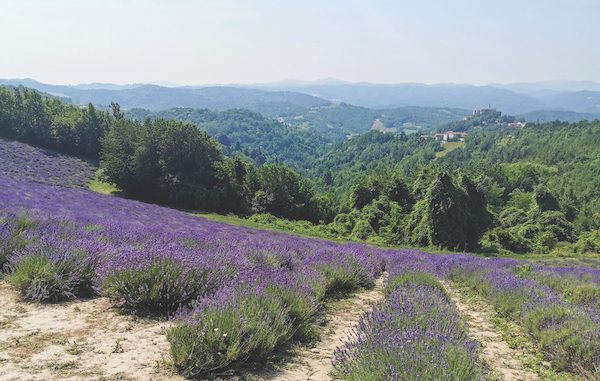
Lavender is commonly associated with the region of Provence in France, but Italy has its own share of violet fields. There’s an area in Piedmont where between June and July the fields turn to vibrant shades of purple, making it one of the most stunning summertime landscapes in Italy. It’s close to the prestigious wine region of Barolo, yet it feels like it’s a million miles away from it.
Visiting this remote part of Piedmont during the lavender season is a true feast for the senses. The air is filled with the sweet scent of herbs and the countryside is painted with an incredible palette of colours, and the gentle buzzing of bumblebees is the only sound to break the peacefulness of the place.
The lavender flowering season usually runs from mid-June to mid-July, although it can vary slightly each year according to the whims of the weather. During this period various festivals, sagre, take place throughout the region, offering a great opportunity to enjoy the local traditions and sample lavender-based products, from skin creams to honey.
Starting from mid-July, lavender is then harvested to create dried bouquets and to extract the essential oils that are used in the cosmetics and herbal industries.
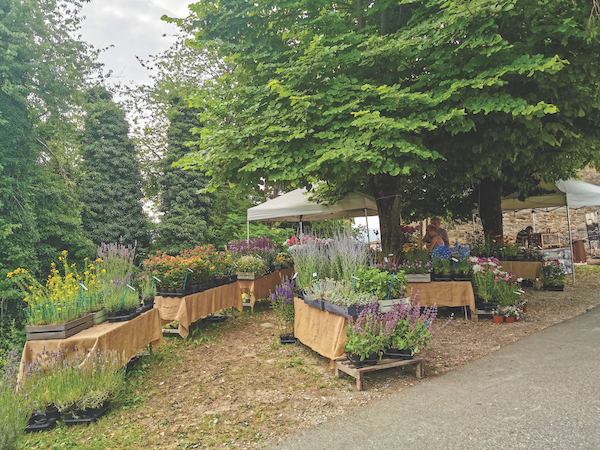
Village of lavender
Home to some 180 happy souls, the sleepy village of Sale San Giovanni has been crowned the capital of this Provençal corner of Piedmont, thanks to its splendid lavender cultivations that stretch over an area of nearly 100 acres. Here the lavender rubs shoulders with other aromatic herbs, and enkir (which is also known to English speakers by its German name, Einkorn). This is the world’s oldest grain variety – it is known to have existed for at least 12,000 years.
But it wasn’t always like this. These cultivations were introduced only a few decades ago in an effort to revamp the territory. The favourable weather conditions of the area and the use of sustainable farming methods did the rest, and now lavender is a precious resource for local farmers, as well as a powerful tourist attraction.
The local municipality has put together three trails that allow visitors to immerse themselves in nature and admire the lavender fields from up close. They range from seven to about ten kilometres and it’s highly recommended that you come well-equipped with comfortable walking shoes and lots of drinking water because temperatures here can be really high at this time of the year. But if trekking is not your thing don’t worry, it is also possible to drive directly to most of the fields!
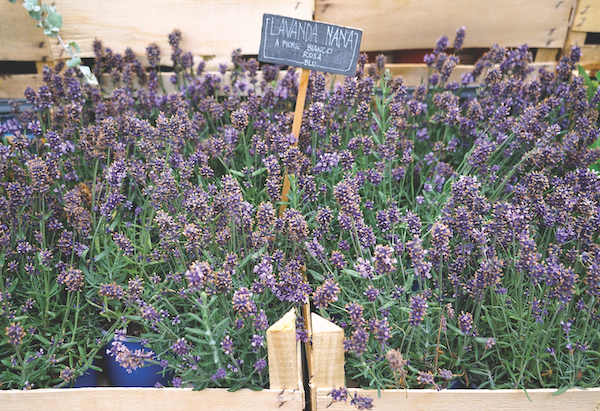
Not only herbs
June is a great time to explore Sale San Giovanni, when the village is all spruced-up for its famous herbal festival, Non Solo Erbe (Not Only Herbs). The event takes place every year on the last weekend of June and it fills the streets with stalls selling everything from flowers to essential oils and lavender-based products. Not to be missed are lavender bread and enkirotto, a risotto made with enkir! You can also join organized tours to explore the lavender fields aboard shuttle buses.
If all this natural beauty is not tempting enough, there are also some precious artistic treasures to explore in Sale San Giovanni. One of these is the tiny Chapel of San Sebastiano, right at the entrance to the village. This shrine was built in the 14th century, at a time when the Black Death was raging throughout Europe, so it’s no surprise to see that its walls are covered with frescoes illustrating the idea that death spares no one, however rich or powerful they may be.
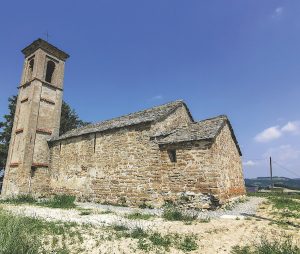
A short walk from the chapel leads to Pieve di San Giovanni Battista, which was erected by Lombard craftsmen on the foundations of a pagan temple towards the end of the 11th century. It served as the local parish church up until the 14th century and its austere façade hides some stunning frescoes spanning from the 13th to the 16th century.
Another site not to miss is the Chapel of Sant’Anastasia, which sits perched high above the lush countryside just a five-minute drive from the centre of Sale San Giovanni. This was built by Benedictine monks around the year 1050 and its small apse contains a large fresco from 1493 centred around the Roman martyr Anastasia.
(Please note that unfortunately these sites are only open to the public on the first and third Sundays of the month, between May and September, or during special events like the herbal festival.)
Sale San Giovanni is also home to the castle of the Marquis Incisa di Camerana, which dominates the centre of the village. The interior is said to be beautiful, but sadly it remains behind locked doors since the castle is a private residence and visits are not allowed.
Just a 15-minute walk away lies another interesting local attraction, Arboreto Prandi, a botanical garden spreading over an area of 30 acres. It was created in the early 1900s by Carlo Domenico Prandi, a local railway worker with a passion for botany who turned his family farm into a stunning forest by collecting and cultivating hundreds of trees and plants from around the world.
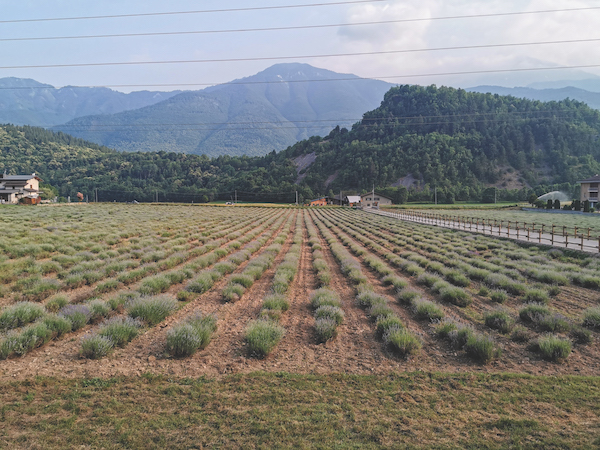
Later lavender blooms
Splendid lavender fields can be seen also in Demonte, about an hour drive from Sale San Giovanni. The lavender plants tend to bloom slightly later here due to the higher elevation, so they are likely to be just starting to sprout when in Sale San Giovanni the fields have already turned purple.
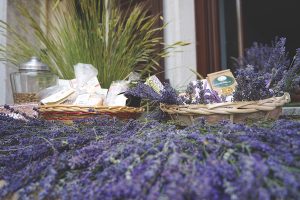
In Demonte, too, lavender is an important economic resource, and one of the oldest lavender businesses in the area, Distilleria Rocchia, is still in full swing. Back in the 19th century, Mr Giuseppe, the founder, developed an innovative distillation process based on steam injection and today his relative Marco continues to produce high-quality essential oils using the ancient family method. The adjoining shop sells a variety of beautiful lavender-themed gift ideas and excellent herbal products.
The village is really charming and filled with Provençal touches, possibly due to its proximity to France (the border is less than an hour away). The main street is lined with attractive medieval porticoes that house small shops and cafés, and there are a number of historical sites that are testament to its interesting past. One of these is the 17th-century Palazzo Borelli, managed by a group of friendly volunteers who will tell you everything about the noble family that used to live here and will show you secret corners. The palace is connected to the public gardens by a delightful corridor filled with antique pieces. Not to miss are also the Church of the Holy Cross and the Church of San Giovanni Decollato, both featuring beautiful frescoed façades and rich interiors.
Did you know
Lavender’s rippling purple swathes are a familiar sight in many countries, from northern Europe to the Mediterranean, in parts of Africa, and in southwest Asia and southeast India. In all there are nearly 50 varieties of this sweet-smelling plant, which is a member of the mint family.
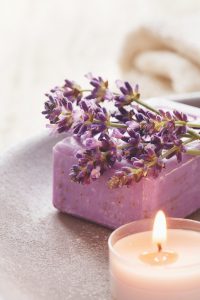
The name lavender (lavendula) comes from the Latin verb lavare, meaning ‘to wash’. It was used in the bathing rituals of ancient Rome for its antiseptic and antibacterial properties, and we undoubtably have the Romans to thank for lavender’s proliferation around their empire, as they introduced their customs and practices (like bathing) to the countries they colonized. It’s a Mediterranean shrub, but it will settle quite contentedly in other regions, from temperate northern Europe to arid climates much further south.
Fragrant and versatile, lavender has many uses: distilled into an essential oil for aromatherapy, in perfumes, beauty products, herbal and holistic medicine, and even in the kitchen as a culinary herb. Some swear by the dried flowers as a moth deterrent, and it’ll keep your bedsheets smelling sweet in the linen cupboard. Summer is the season to catch it in bloom, with fields to be found all over Italy.
For the best places to eat and stay in the area, check out Valentina’s Cuneo travel guide
